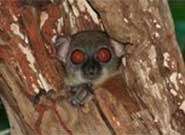Solitary lemurs avoid danger with a little help from the neighbours

(Phys.org) —An endangered species of Madagascan lemur uses the alarm calls of birds and other lemurs to warn it of the presence of predators, a new study by researchers from the University of Bristol and Bristol Zoo with the University of Torino has found. This is the first time this phenomenon has been observed in a solitary and nocturnal lemur species.
Very little is known about the Sahamalaza sportive lemur (Lepilemur sahamalazensis), other than the fact it roosts during the day in rather open situations, such as tree holes, and therefore risks falling victim to predators from both the air and the ground.
Sportive lemurs are not kept in any zoo. Prior to this research virtually nothing was known about this particular species despite the fact that it has been classified as Critically Endangered, the top threat category of the International Union for Conservation of Nature's (IUCN) Red List of Threatened Species, at a red-listing workshop in Madagascar in July 2012.
Dr Melanie Seiler, a researcher at Bristol Zoo and the University of Bristol, and lead author of the study, said: "We were seeking any information we could gather that could help us understand this species better, with the objective of improving targeted conservation efforts.
"One of the problems of small nocturnal species is that they don't get a great deal of scientific or conservation attention. The Sahamalaza sportive lemur doesn't have striking blue eyes like blue-eyed black lemurs or any other unusual features. That means that no-one had really looked into what these animals need to survive."
Dr Marc Holderied of the University of Bristol said: "Until our study, a solitary and nocturnal lemur species had never been tested to see if it could understand other species' alarm calls and differentiate between them. We were also the first to test any species of lemur to see if it could recognise the alarm calls of a non-primate species."
The researchers found that the vigilance of sportive lemurs significantly increased after they heard playbacks of the alarm calls of the crested coua and the Madagascar magpie-robin. They also responded with increased vigilance to the aerial alarm calls of the blue-eyed black lemur, scanning towards the sky but never the ground which suggests they classified the alarm call correctly.
Dr Holderied said: "Our results indicate that the Sahamalaza sportive lemur is capable of gleaning information on predator presence and predator type from the referential signals of different surrounding species. Examples for cross-species semantics in lemurs are rare, and this is the first record of lemurs using information across vertebrate classes."
The lemurs of Sahamalaza National Park in northwest Madagascar are threatened by deforestation, hunting and forest fragmentation. Bristol Zoo is working to preserve the small bits of forest, roughly 200 hectares on the Sahamalaza Peninsula, that they have left which is vitally important for the continued survival of this and other lemur species.
More information: 'Interspecific semantic alarm call recognition in the solitary Sahamalaza sportive lemur, Lepilemur sahamalazensis' by Melanie Seiler, Christoph Schwitzer, Marco Gamba and Marc Holderied in PLoS ONE.
Journal information: PLoS ONE
Provided by University of Bristol



















